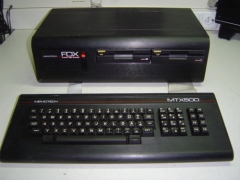| Specifications | Single Density | Double Density (FDX) |
|---|---|---|
| Capacity (per disk)* | Unformatted 250k | Unformatted 500k |
| Formatted 163k | Formatted 327k | |
| Recording Density | 2938 BPI | 5876 BPI |
| Track Density | 48 TPI | 48 TPI |
| Cylinders | 40 | 40 |
| Tracks | 80 | 80 |
| Recording Method | FM | MFM |
| Rotational Speed | 300 RPM | 300 RPM |
| Transfer Rate | 125k bits/sec | 250k bits/sec |
| Average Latency | 100 ms | 100 ms |
| Average Access Time | 160 ms | 160 ms |
| Track-to-track Seek Time | 12 ms (6 ms optional) | 12 ms (6 ms optional) |
| Spindle Drive Mechanism | Belt | Belt |
* The capacities shown are from the drive manufacturers data sheets, when used with Memotech systems, the disk capacity was dictated by the format used, in the case of a FDX Type 03, this was 256 bytes per sector, 16 sectors per track and 80 tracks, giving a formatted capacity of 320k.
|
Photos will appear here |
||
Maintenance Issues (from http://www.lo-tech.co.uk/)
Common problems this many years from manufacture include:
-
Dirty heads. Gently wipe over both heads with a cotton bud dipped in isopropanol.
-
Sticky head mechanism. The service manual states that a 50g weight attached to the head mechanism should be enough to pull the head to either stop, with the drive on end as required. In practice the head mechanism should move easily. It is prone to become sticky especially at the ends of travel, in which case the drive may fail a BIOS seek test (reporting floppy drive failure).
This can be easily resolved by first cleaning the three rails thoroughly (again with cotton bud dipped in isopropanol) and then applying a little grease again with a cotton bud, and moving the heads a few times to get an even and thin coating on the rails. Finally wipe away any excess. -
Stiff lock handle, with poor spring tension when released. Again a lubrication issue. Close the door lock, and remove the screw from the door pin actuator at the front of the drive (a single cross-head screw) and slide it back a little. Next stand the drive on end as required and apply one drop of 3-in-one oil to the door lock shaft ends, such that it runs down in to the plastic bearing. Reposition and secure the door pin actuator and open the drive lock, and then apply a little grease to the spring cam half way along the shaft on the faces that will turn against the spring. Finally operate the lock a few times to work the oil and grease in fully.
-
Dirty optos. There are three opto sensors - read-only tab, disk position, and head track 0 position. All three can be cleaned with a cotton bud dipped in isopropanol that has first been compressed such that it will fit in the openings.
The Qume Maintenance Manual for this drive is available on my Manuals Page.
Both of my FDXs were fitted with QumeTrak drives, the ones in my original MTX were fine when last used in the late 1980s and also appeared to work when last tried in 2009, but sadly, both failed in short order after being fired up again in 2013. The drives in the FDX that I bought off ebay in 2009 both appeared to be faulty when I received the FDX. I am currently looking for replacement drives to resurrect my FDXs.
Epson SD-521
|
Physical Specifications |
|
| Capacity* | Unformatted 500k |
| Formatted 360k bytes (IBM) | |
| Recording Density | 5876 BPI |
| Track Density | 48 TPI |
| Cylinders | 40 |
| Tracks | 80 |
| Recording Method | MFM |
| Rotational Speed | 300RPM |
| Transfer Rate | 250k bits/sec |
| Average Latency | |
| Average Access Time | |
| Track-to-track Seek Time | 6 ms |
| Spindle Drive Mechanism | Direct |
|
Photos will appear here |
||
These drives were also popular with other computer manufacturers, but surprisingly, I have been unable to locate any additional information about them, if you are aware of any documentation - User Guide, Service Manual, etc. please let me know.











